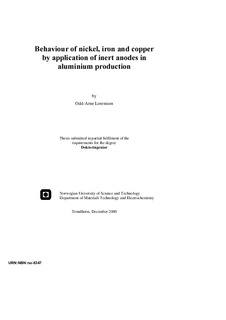| dc.description.abstract | A thorough investigation was performed on the behaviour of Ni, Fe and Cu oxides dissolved in cryolite melts, and the solubility of these species was measured as a function of alumina content, NaF/AlF3 molar ratio (CR) and temperature. Predominance area diagrams showing the solid phases containing Ni, Fe and Cu, respectively, as a function of the partial oxygen pressure and the alumina activity at 1020 oC were constructed. These diagrams were based on present emf and solubility measurements.
The interpretations of the solubility measurements for the oxides of Ni and Fe gaveconclusive and consistent results. The oxides of Ni and Fe exhibit decreasing solubility with decreasing temperature and with increasing alumina concentration. The Ni(II) concentration decreased from 0.32 wt% in cryolite to 0.003 wt% in alumina-saturated melts, while that of Fe(II) decreased from 4.17 to 0.32 wt% in similar melts. FeO and NiO are stable solid phases at low alumina concentrations, while FeAl2O4 and NiAl2O4 are stable at high concentrations. The alumina concentrations corresponding to the points of coexistence between FeO and FeAl2O4 and between NiO and NiAl2O4 were determined to be 5.03 and 3.0 wt% Al2O3, respectively, corresponding to the following Gibbs energy of formation from the oxide compounds,∆G0fNiAl2o4 = –28.6 ± 2 kJ/mol and ∆G0f FeAl2O4 = –17.6 ± 0.5 kJ/mol.
The solubilities of FeAl2O4 and NiAl2O4 as a function of the CR were investigated in alumina-saturated melts at 1020 oC. For both compounds a maximum solubility was found at CR ~5, being 0.008 wt% Ni(II) and 0.62 wt% Fe(II). The results are discussed with respect to the species present in solution. Both Fe(II) and Ni(II) dissolve as fluorides with different numbers of associated “NaF’s”. Ni(II) seems to form Na3NiF5 in melts with molar ratios 2 to 12, while Fe(II) is present as NaFeF3 in acidic (CR 3–10) melts and as Na3FeF5 and probably some Na4FeF6 in basic melts (CR > 3).
The solubility of both Cu oxidation states Cu(I) and Cu(II) decreases with decreasing temperature. The solubilities of Cu(I) initially decreased with increasing alumina concentration, showing a minimum at a certain alumina concentration followed by an increase. The solubilities were 0.36 wt% Cu(I) and 0.92 wt% Cu(II) in cryolite, and 0.30wt% Cu(I) and 0.45 wt% Cu(II) in alumina-saturated cryolite at 1020 oC.
At 1020 oC the solubilities of Cu2O and CuO were little influenced when changing the CR from 3 to 8 in alumina-saturated melts (~0.30 wt% Cu(I) and ~0.45 wt% Cu(II)), but there was an upward trend for CR < 3. Solubility measurements for CuO in alumina-saturated melts at CR 3.0 to 1.2 clearly showed that the saturation concentration is dependent on both temperature and melt composition.
Copper ions in solution show a complex behaviour, since they form fluorides and oxycomplexes simultaneously. The extent of co-existence of Cu(I) and Cu(II) in the same melt is also considerable, and it is depending on the alumina activity in the melt. According to thermodynamics the stable copper oxide phases at high alumina activities are the aluminates CuAlO2 and CuAl2O4. However, no clear changes in the solubilities were found for the points of coexistence between Cu2O and CuAlO2 and CuO and CuAl2O4, respectively, as was the case for Ni(II) and Fe(II). Although there are uncertainties regarding the thermodynamic data available for the formation of copper aluminates, models for the dissolution mechanisms and for the species present in the melt are suggested. Cu(I) seems to form mainly CuF at low alumina contents, while Na5CuO3 dominates at higher alumina concentrations. Likewise, Cu(II) seems to form CuF2, but the concentration of CuF2 decreases with increasing alumina content. The species that gave the best fit for the cupric oxy-complexes was Na16CuO9, and the amount increased with increasing alumina content.
Cermet anodes were prepared with a NiFe2O4-based oxide phase mixed with a ~20 wt% copper-rich metal phase. The electrical conductivity for these materials was measured as a function of temperature, showing semiconductor behaviour in the temperature range from room temperature to 1050 oC. The highest electrical conductivity measured was ~30 S/cm at 1000 oC, which is on the low side for use as an anode material for aluminium production.
Three cermet anodes were tested by electrolysis for 48 hours. After the experiments the anodes were examined with SEM. There was no metal phase present in the outer 100 µm of the anode, not even pores were observed that could indicate where the metal grains had been. A copper-rich phase was found in one case ~2 mm from the outer surface, and it is believed that copper diffuses out of the anode.
The cermet anodes dissolved slowly in the electrolyte during electrolysis. The steady state concentrations of Fe and Cu in the electrolyte were below the saturation concentrations, while the concentration of Ni was 3 - 4 times above saturation. The dissolution of the anode does not fit a first order mass-transport model, but it can probably be explained by a controlled dissolution mechanism with some additional disintegration/spalling of the anode material. Further work is needed to draw a firm conclusion. In general, correct solubility data for the anode constituents are needed to make a proper evaluation of various anode materials. Perhaps the first order mass-transport model agrees for some materials, but based on the present results it seems untenable for cermet materials made of NiFe2O4 with a copper-rich metal phase.
The solubilities of the oxides of Ni(II) and Fe(III) are very low for the alumina-saturated melt used during electrolysis, which make them promising candidates for inert anodes. However, if nickel aluminate, which is an insulator, is formed and deposited on the anode surface, it is a cause of concern. Fe(II) aluminate is not expected to form on the anode surface, since Fe(III) is the stable oxidation state in the presence of oxygen gas. However, solid Fe(II) aluminate may be formed in the bulk of the electrolyte where the partial oxygen pressure is lower. | nb_NO |
